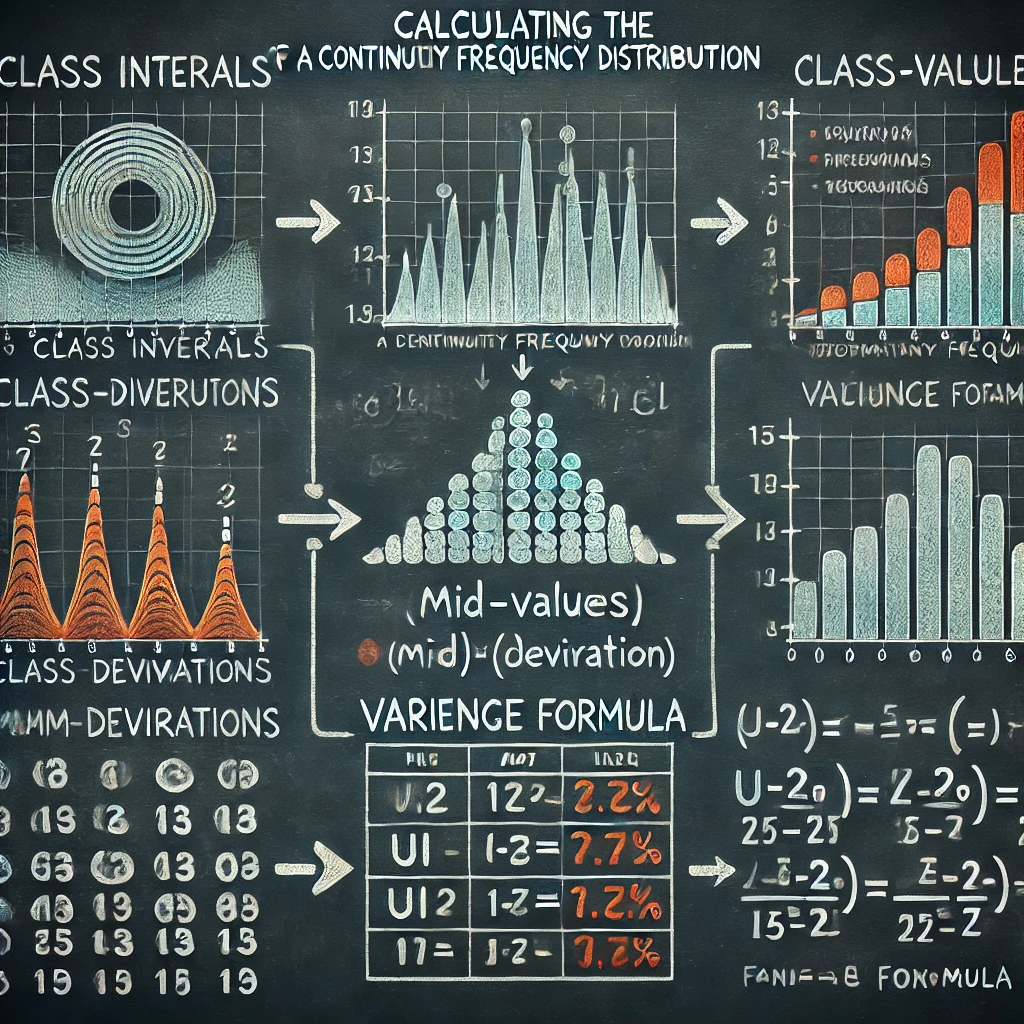Title: How to Calculate Variance of Continuous Frequency Distribution
Introduction:
In statistics, variance is a measure of the spread of a distribution. For continuous frequency distributions, variance helps determine how data points differ from the mean. In this tutorial, we’ll go through the steps to calculate variance using a frequency distribution table.
Understanding the Frequency Distribution Table
Below is a table representing the frequency distribution of a data set:
| Class Interval | fi | Mid Values xi | ui=\(\frac{x_i – A}{h}\) | fi ui | ui2 | fi ui2 |
|---|---|---|---|---|---|---|
| 0-15 | 12 | 7.5 | 4 | -48 | 16 | 192 |
| 15-30 | 18 | 22.5 | 3 | -54 | 9 | 162 |
| 30-45 | 35 | 37.5 | 2 | -70 | 4 | 140 |
| 45-60 | 42 | 52.5 | 1 | -42 | 1 | 42 |
| 60-75 | 50 | 67.5 | 0 | 0 | 0 | 0 |
| 75-90 | 45 | 82.5 | 1 | 45 | 1 | 45 |
| 90-105 | 20 | 97.5 | 2 | 40 | 4 | 80 |
| 105-120 | 8 | 112.5 | 3 | 24 | 9 | 72 |
– \(N = \sum f_i = 230\)
– \(\sum f_i u_i = -105\)
– \(\sum f_i u_i^2 = 733\)
—
Steps to Calculate Variance
1. Identify the Class Midpoints (\(x_i\)):
Midpoints are calculated as the average of the class intervals.
2. Determine Deviations (\(u_i\)):
The deviations \(u_i\) are calculated as \(u_i = \frac{x_i – A}{h}\), where \(A\) is the assumed mean and \(h\) is the class width. Here, \(A = 67.5\) and \(h = 15\).
3. Calculate \(f_i u_i\) and \(f_i u_i^2\):
These are the products of frequencies and their corresponding deviations.
4. Variance Formula:
The formula for variance of a continuous frequency distribution is:
\[
Var(X) = h^2 \left(\frac{1}{N} \sum f_i u_i^2 – \left(\frac{\sum f_i u_i}{N}\right)^2 \right)
\]
Where:
– \(h = 15\)
– \(N = 230\)
– \(\sum f_i u_i = -105\)
– \(\sum f_i u_i^2 = 733\)
5. Plugging in the Values:
\[
Var(X) = (15)^2 \left(\frac{733}{230} – \left(\frac{-105}{230}\right)^2 \right)
\]
Simplifying further:
\[
Var(X) = 225 \times (3.18696 – 0.20802) = 225 \times 2.97894 = 669.93
\]
So, the variance of the distribution is approximately **669.93**.
Video
PDF Presentation
var cfd ex 3Conclusion:
The variance for the given continuous frequency distribution was calculated as **669.93** using the step-by-step method outlined. Variance gives us valuable insight into how the data is distributed around the mean, and it is a fundamental concept in statistics.
This post will help others understand the calculation of variance for continuous frequency distributions using a clear example.
